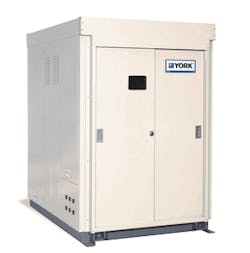Absorption Chillers: How Heat Drives Efficient Cooling (AHR Expo)
What are you doing with your waste heat? If you’re exhausting it outside, it’s time to take a second look at how you can repurpose the warmth generated by your facility’s other mechanical equipment.
Waste heat and other low-cost sources of excess heat are the driving force behind absorption chillers, an energy-efficient cooling technology that uses heat to produce cold.
How Absorption Chillers Work
“Think of heat as energy,” explains Brian Smith, director of marketing for Johnson Controls, which recently introduced an absorption chiller. “In an electric chiller, the energy is electricity, and it’s that energy that spins the motor and drives the whole process. In an absorption chiller, you’re using heat to drive a chemical process. That chemical process allows you to do the same functions of evaporating, condensing and compression.”
AHR Expo Featured Product
York® Absorption Chillers & Heat Pumps
YORK® is launching its absorption chillers and heat pumps in North America, expanding their portfolio of environmentally friendly heating and cooling solutions. These products use only a natural refrigerant (water) and are driven by waste or other low-cost heat sources.
The refrigerant in a typical chiller is replaced by water in an absorption chiller, so users don’t have to worry about older refrigerants being phased out or measuring the global warming potential of newer products. The chemical process Smith refers to is absorption, in which the water and an absorbent (usually lithium bromide or an ammonia-water mix) are separated and recombined to produce a cooling effect.
The heat that powers this process can come from anywhere your facility generates extra heat that you don’t want, such as the exhaust from a steam turbine or engine jacket water, Smith says. Instead of exhausting heat or sending excess steam to your cooling tower via a condenser, you can now use it to make building occupants more comfortable.
[Related: 5 Trends in HVAC that are Improving Efficiency]
“Heat has value, and people are spending money to throw it away,” says Smith. “Absorption lets you take that heat and create cooling.”
The technology can deliver a payback of less than a year when you account for the cost of condensing and cooling steam that could be used to drive an absorption chiller, Smith adds.
Help BUILDINGS Shape 2019!
What BUILDINGS resources are most valuable to you? What would you like to see us provide?
Please take our short (under 2 minutes) survey - just 5 short questions.
Thank you!
4 Ways to Tell if Absorption Chillers Are Right For You
The Department of Energy suggests a four-step process to determine whether an absorption chiller is a good solution for at least part of your cooling load.
1. Figure out where you’ll get the heat from. Survey your building to find sources of waste heat and waste steam and see how much will be available.
2. Compare your supply to your cooling load. Determine your current cooling requirements. See how much it will cost to meet those needs with your existing mechanical chillers versus new, more efficient mechanical equipment.
3. Get an estimate. Reach out to suppliers and gather installed cost quotes for absorption chillers.
4. Conduct a lifecycle analysis. Compare your absorption chiller quotes to the cost of new mechanical equipment (as well as the cost of “business as usual” using your current equipment). Determine if the new absorption chiller can adequately serve your needs and meets your organization’s requirements for cost-effectiveness.
More AHR Expo coverage:
About the Author
Janelle Penny
Editor-in-Chief at BUILDINGS
Janelle Penny has been with BUILDINGS since 2010. She is a two-time FOLIO: Eddie award winner who aims to deliver practical, actionable content for building owners and facilities professionals.


